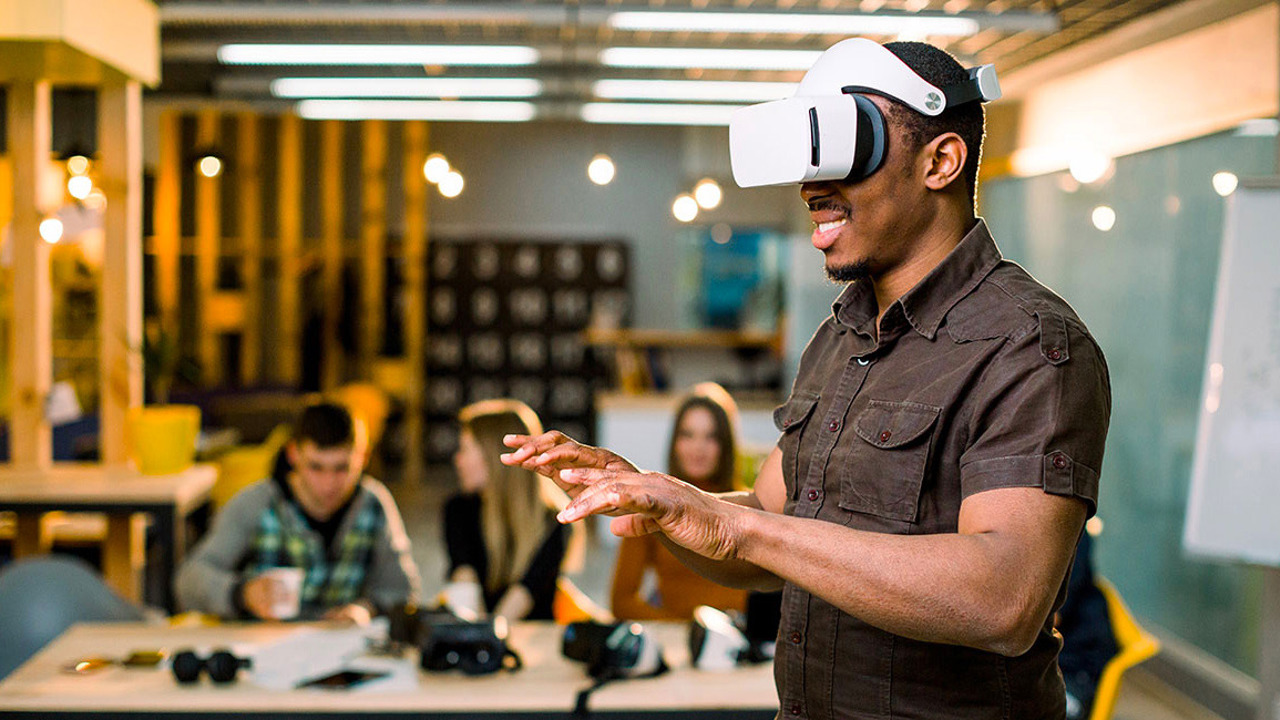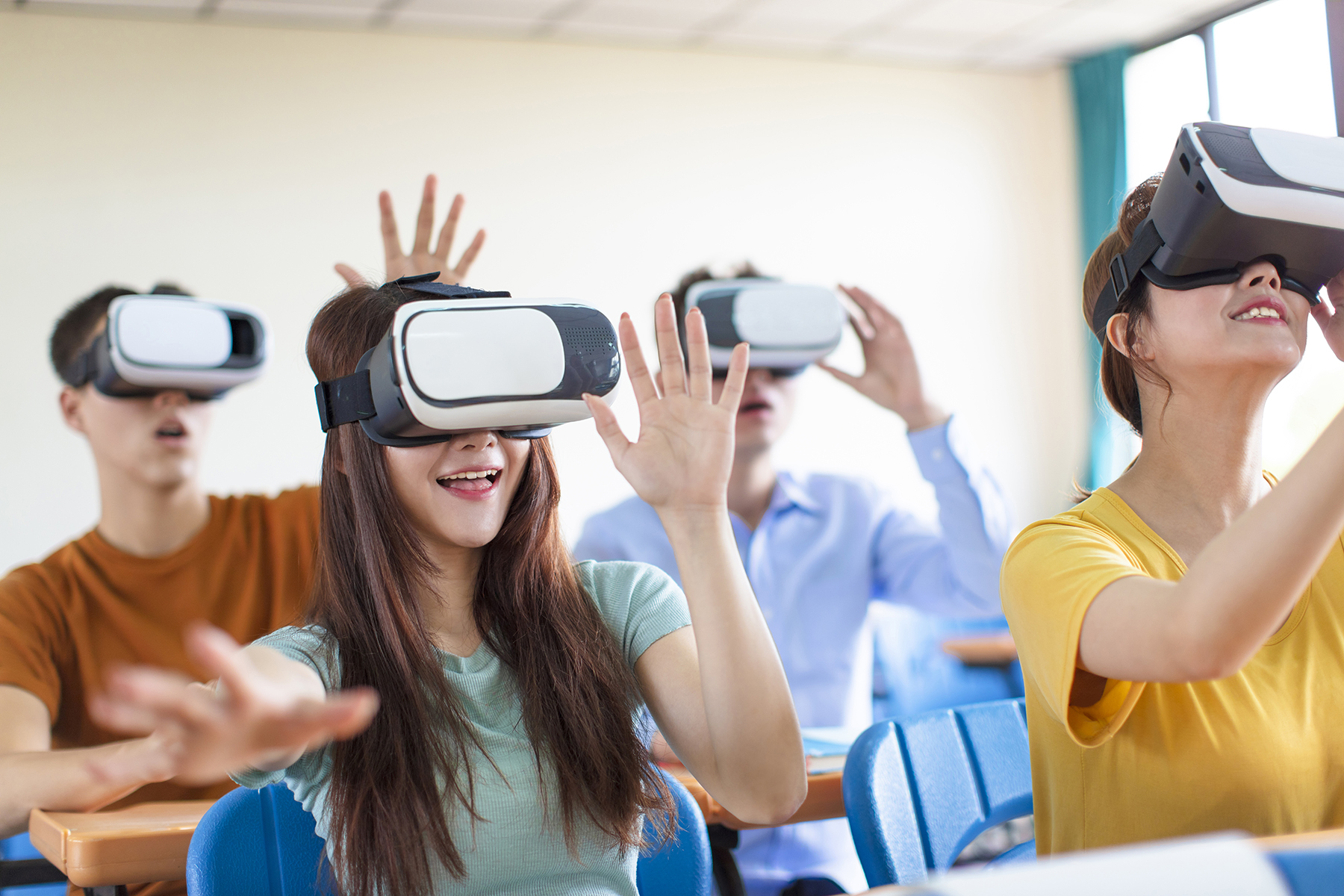Introduction
Virtual reality (VR) has revolutionized various industries and is now making its way into the workplace. With its immersive capabilities, VR technology brings a new level of engagement and interactivity to professional environments. But it’s not just about creating a fun and captivating experience – virtual reality also has the potential to make work experiences more inclusive.
In today’s rapidly evolving world, inclusivity is a key focus for organizations striving to create diverse and welcoming work environments. It is imperative to ensure that all employees, regardless of their backgrounds or abilities, have equal opportunities to thrive and contribute to the success of the organization. Here’s where virtual reality steps in, offering a range of possibilities to promote inclusivity and improve work experiences.
By creating virtual environments that are accessible and adjusted to individual needs, virtual reality enables companies to foster a more inclusive workplace culture. This technology has the power to break barriers, bridge communication gaps, and provide unique opportunities for employees to learn, grow, and collaborate.
In this article, we will explore the ways in which virtual reality is helping to make work experiences more inclusive. We will delve into the importance of inclusivity in the workplace and examine how virtual reality promotes diversity, empowers individuals with disabilities, enhances cultural understanding, encourages remote work and collaboration, mitigates bias and discrimination, strengthens team dynamics, and fosters empathy and understanding.
Join us as we dive into the world of virtual reality and discover the exciting possibilities it offers for creating a more inclusive and empowering work environment.
What is Virtual Reality?
Virtual reality (VR) is an immersive technology that allows individuals to experience a computer-generated 3D environment that feels incredibly real. By using specialized headsets, users are transported into a virtual world that can be visually and audibly simulated. They can interact with this virtual environment through gestures, controllers, or even body movements, creating a sensation of being physically present in the digital space.
VR technology typically involves the use of a head-mounted display (HMD) that covers the user’s eyes and ears, blocking out the real world and replacing it with a computer-generated simulation. This display is often accompanied by motion-tracking sensors or controllers, enabling the user to move and interact within the virtual environment.
The virtual reality experience is characterized by a high level of immersion, where the user’s senses are tricked into believing that the virtual world is real. This can be achieved through high-definition visuals, accurate spatial audio, and even haptic feedback, which provides tactile sensations through vibrations or force feedback devices.
Virtual reality has evolved greatly over the years, and its applications are now widespread across various industries. From gaming and entertainment to healthcare, education, and now the workplace, the potential of VR technology is vast and continually expanding.
In recent years, VR has gained traction in professional settings, as companies recognize its transformative capabilities. By simulating realistic scenarios and environments, VR enables users to practice skills, learn new concepts, and collaborate with others in a safe virtual space. It has the power to transport individuals to different locations, eradicating physical barriers and making remote experiences feel more intimate and connected.
Overall, virtual reality is a cutting-edge technology that provides a novel and immersive way for individuals to engage with digital content. Its ability to create realistic and interactive experiences has paved the way for innovative applications in various industries. In the workplace, virtual reality holds tremendous potential to promote inclusivity and enhance work experiences for all employees.
The Importance of Inclusivity in the Workplace
Inclusivity is a fundamental value that organizations should prioritize to foster a positive and thriving work environment. When workplaces embrace inclusivity, they create an atmosphere where individuals of all backgrounds, abilities, and perspectives feel valued, respected, and empowered to contribute their unique talents.
One of the key reasons why inclusivity is vital in the workplace is the diverse range of perspectives it brings. Different experiences, cultural backgrounds, and ways of thinking lead to a richer pool of ideas and innovative solutions. An inclusive workplace encourages collaboration, creativity, and critical thinking, as individuals feel comfortable expressing their thoughts without fear of judgment or exclusion.
Furthermore, promoting inclusivity in the workplace is not only ethically right but also strategically advantageous. Companies that prioritize inclusivity can attract and retain top talent from a diverse pool of candidates. This enables them to tap into a broader range of skills, expertise, and perspectives, leading to increased innovation and better decision-making.
Beyond the ethical and strategic considerations, inclusivity also plays a crucial role in fostering a positive work culture. An inclusive work environment cultivates a sense of belonging, employee engagement, and overall job satisfaction. Individuals who feel included are more likely to be motivated, productive, and committed to their work. They also experience fewer instances of stress, anxiety, and burnout, fostering better mental health and well-being.
Inclusivity in the workplace is not limited to championing diversity among employees. It also extends to accommodating individuals with disabilities or special needs. By creating an inclusive environment that caters to their needs, organizations can ensure that everyone has equal opportunities to succeed and contribute to the best of their abilities.
In summary, inclusivity is of utmost importance in the workplace. It leads to a more diverse and innovative workforce, fosters a positive work culture, and enhances employee engagement and well-being. By embracing inclusivity, organizations can create a nurturing and empowering environment where all employees can thrive and achieve their full potential.
How Virtual Reality Promotes Inclusivity at Work
Virtual reality (VR) technology has emerged as a powerful tool for creating more inclusive work environments. Its immersive nature opens up a world of possibilities to promote diversity, empower individuals with disabilities, enhance cultural understanding, and encourage remote collaboration. Let’s explore how virtual reality promotes inclusivity at work.
For employees with disabilities, virtual reality can provide equal opportunities by creating accessible and adjusted environments. VR simulations can replicate real-world scenarios and tasks, allowing individuals to practice and develop their skills in a safe and supportive virtual space. This enables employees with disabilities to bridge the gap and perform their jobs effectively, all while building confidence and independence.
In terms of diversity and cultural understanding, virtual reality can break down barriers and foster empathy. Through immersive experiences, employees can virtually visit different cultures and environments, expanding their cultural knowledge and understanding. This promotes diversity appreciation, reduces biases, and encourages a more inclusive and tolerant work environment.
Virtual reality also facilitates remote work and virtual collaboration, making it easier for employees to connect and contribute regardless of their physical location. VR platforms offer virtual meeting spaces where employees can interact in real-time, collaborate on projects, and cultivate a sense of teamwork and camaraderie. Remote workers can also participate in training sessions, workshops, and events, ensuring that they are not left out of important professional development opportunities.
Overcoming bias and discrimination is another area where virtual reality excels. By using simulation scenarios, VR can raise awareness about unconscious biases, helping employees recognize and challenge their own prejudices. It can create immersive experiences that simulate discrimination, enabling individuals to understand and empathize with marginalized groups better. This fosters a more inclusive and respectful work environment.
Furthermore, virtual reality enhances team dynamics and communication skills. VR-based team-building exercises and simulations simulate real-world challenges, requiring collaboration, problem-solving, and effective communication. This helps employees develop their interpersonal skills, build trust, and improve teamwork. Individuals from different backgrounds and perspectives can come together in a virtual space, fostering a sense of unity and shared goals.
Finally, virtual reality can be a powerful training tool for promoting empathy and understanding among employees. VR simulations can place individuals in someone else’s shoes, allowing them to experience daily challenges and barriers faced by marginalized groups. This empathy-building approach helps employees develop a deeper understanding and appreciation for the experiences of others, leading to a more inclusive and compassionate work environment.
In summary, virtual reality offers various ways to promote inclusivity at work. By creating accessible environments, enhancing cultural understanding, enabling remote collaboration, overcoming biases, strengthening teamwork, and fostering empathy, virtual reality can contribute to creating a more inclusive and equitable workplace for all employees.
Empowering Employees with Disabilities through Virtual Reality
One of the significant ways virtual reality (VR) promotes inclusivity in the workplace is by empowering employees with disabilities. VR technology offers unique opportunities for individuals with disabilities to overcome physical barriers, gain confidence, and enhance their professional skills in a supportive virtual environment.
For employees with physical disabilities, VR simulations can provide a level playing field by creating accessible and adjusted environments. Through VR, individuals can practice and refine their motor skills, spatial awareness, and coordination. For example, someone with mobility challenges can use VR to simulate tasks that require physical movements, such as operating machinery or navigating through a space. This allows them to develop their abilities and build the necessary muscle memory, all within a safe and controlled virtual setting.
Furthermore, VR-based training programs can enable employees with cognitive or sensory disabilities to learn and practice tasks at their own pace. The immersive nature of VR helps individuals focus on specific skills and eliminates distractions present in the physical workplace. Visual and auditory cues can be adapted to suit individual needs, ensuring that information is delivered in a way that is easily processed and understood. This empowers employees with cognitive or sensory disabilities to grasp new concepts, reinforce learning, and perform their job responsibilities effectively.
Virtual reality also provides a valuable platform for employees with disabilities to build confidence and independence. It offers a safe space where they can practice and experiment without fear of judgment or negative consequences. By giving individuals the ability to repeatedly engage in simulated scenarios, VR allows them to gain confidence and become proficient in their work tasks. This increased confidence can then translate into higher job satisfaction, better performance, and improved overall well-being.
Moreover, VR can help employees with disabilities navigate the workplace more easily by creating virtual maps and guiding systems. These assistive tools can help individuals with visual impairments or mobility challenges move around the office, locate resources, and access the necessary facilities. By enhancing accessibility and ease of navigation, virtual reality ensures that employees with disabilities can fully participate in work activities and have equal access to all areas of their workplace.
In summary, virtual reality technology empowers employees with disabilities by providing accessible environments, customizable training programs, opportunities for skill development, and assistive tools for navigation. By harnessing the power of VR, organizations can create a more inclusive and empowering work environment, enabling all employees to contribute to their fullest potential, regardless of their disabilities.
Enhancing Diversity and Cultural Understanding with Virtual Reality
Virtual reality (VR) technology has emerged as a powerful tool for enhancing diversity and promoting cultural understanding in the workplace. By immersing employees in realistic virtual environments, VR provides unique opportunities to experience different cultures, challenge biases, and foster a more inclusive work culture.
One of the main ways VR enhances diversity is by creating immersive experiences that allow employees to virtually visit diverse cultural settings. Through VR simulations, individuals can explore different countries, landmarks, historical sites, and cultural events, all from the comfort of their workplace. This exposure to diverse cultures fosters an appreciation for different customs, traditions, and ways of life. It encourages individuals to embrace diversity and challenges stereotypes or preconceived notions they may hold.
Moreover, VR can provide employees with the opportunity to participate in training programs that focus on cultural competency. By simulating real-life scenarios, VR allows individuals to navigate cross-cultural interactions and develop the necessary skills to communicate and collaborate effectively in diverse work environments. This type of training can help employees better understand cultural nuances, improve their cross-cultural communication skills, and foster a more inclusive and harmonious workplace.
In addition to enhancing diversity, VR also helps employees develop empathy towards individuals from different cultures and backgrounds. Through the immersive nature of VR, individuals can virtually step into someone else’s shoes and experience life from their perspective. These empathy-building experiences can be incredibly powerful in eradicating biases, eliminating stereotypes, and fostering a genuine understanding of the challenges faced by individuals from marginalized groups.
Virtual reality can also facilitate virtual meetings, bringing together employees from different locations and cultural backgrounds in a more intimate and connected way. By using VR platforms, employees can gather in a shared virtual space, collaborating on projects, sharing ideas, and fostering cross-cultural teamwork. This virtual collaboration encourages diverse perspectives, improves problem-solving, and promotes a sense of unity among team members regardless of their physical location.
Another area where VR enhances cultural understanding is by providing language learning and translation support. With VR technology, individuals can immerse themselves in language lessons, practicing pronunciation, vocabulary, and cultural context within a realistic virtual environment. This enables employees to enhance their language capabilities in a more interactive and engaging manner while also gaining insight into the cultural nuances associated with the language.
In summary, virtual reality technology has the power to enhance diversity and cultural understanding in the workplace. Through immersive experiences, cultural competency training, empathy-building simulations, virtual collaboration, and language support, VR enables employees to embrace diversity, break down cultural barriers, and fosters a more inclusive work environment. By utilizing VR in this way, organizations can harness the richness of diverse perspectives and create a more culturally aware and accepting workplace.
Encouraging Remote Work and Virtual Collaboration for All
In recent times, remote work and virtual collaboration have become increasingly prevalent in the workplace. Virtual reality (VR) technology plays a vital role in facilitating and enhancing remote work experiences for employees, fostering inclusivity, and ensuring equal opportunities for all.
One of the significant benefits of VR in remote work is the ability to create a sense of presence and connection. VR platforms enable employees to come together in a shared virtual environment, regardless of their physical location. Through avatars and real-time communication, team members can collaborate, brainstorm, and engage in discussions as though they were in the same room. This virtual collaboration breaks down geographic barriers and creates a more inclusive work environment where distance is no longer a hindrance.
Furthermore, VR allows remote employees to feel more engaged and involved in company-wide events and meetings. By immersing themselves in the virtual space, remote workers can participate in town hall meetings, training sessions, and conferences, as if they were physically present. This inclusion ensures that remote employees have equal access to important information, professional development opportunities, and networking events, regardless of their physical location.
Virtual reality also provides a level playing field for virtual collaboration, allowing all employees to contribute their ideas and perspectives without bias. In virtual environments, factors such as age, gender, or physical appearance become less significant, and the focus shifts to the quality of ideas and the ability to communicate effectively. This inclusion fosters a more diverse and inclusive work culture that encourages active participation and values contributions from all team members, regardless of their background.
For employees with disabilities or mobility challenges, VR technology offers a unique opportunity to work remotely and thrive in a virtual workspace. By accessing virtual office spaces through VR headsets, individuals can perform their job responsibilities, collaborate with colleagues, and engage in professional development activities. This flexibility allows employees with disabilities to overcome physical barriers, participate fully in work activities, and maintain a healthy work-life balance.
Moreover, VR facilitates virtual training programs that can be accessed remotely by all employees. Through simulated scenarios, VR enables individuals to learn and develop their skills in a hands-on and interactive way, regardless of their physical location. Remote workers can also participate in team-building activities, soft skills training, and leadership development programs, fostering professional growth and ongoing learning opportunities for all.
By encouraging remote work and virtual collaboration through VR, organizations can tap into a global talent pool and attract diverse individuals who may prefer or require flexible work arrangements. This inclusivity not only contributes to a more diverse workforce but also promotes better work-life balance, improved job satisfaction, and increased retention rates.
In summary, virtual reality technology is a powerful enabler of remote work and virtual collaboration, promoting inclusivity and equal opportunities for all employees. By creating a sense of presence, ensuring participation in company-wide events, facilitating equal access to information and professional development, and empowering individuals with disabilities, VR enhances remote work experiences and creates a more inclusive and engaging work environment for all employees.
Overcoming Bias and Discrimination through Virtual Reality Simulations
Bias and discrimination are significant challenges faced by organizations in creating an inclusive work environment. Virtual reality (VR) technology offers a unique opportunity to address and overcome these issues by immersing individuals in simulated scenarios that challenge biases and foster empathy and understanding.
One of the ways VR tackles bias and discrimination is by creating immersive experiences that raise awareness about unconscious biases. By simulating real-life scenarios in which biases may be present, VR allows individuals to recognize and confront their own biases in a safe and controlled environment. Through these simulations, employees can gain a better understanding of the impact of biases on decision-making and interactions with others, encouraging them to challenge and mitigate these biases in their everyday work.
Moreover, VR can create empathy-building experiences by allowing individuals to virtually step into the shoes of individuals who have experienced discrimination. By simulating firsthand experiences, VR helps individuals develop a deeper understanding of the challenges faced by marginalized groups and fosters empathy and compassion. This increased empathy can lead to more inclusive behaviors, improved communication, and a greater willingness to challenge discriminatory practices in the workplace.
Virtual reality can also be used to provide diversity and inclusion training that goes beyond traditional approaches. VR simulations can expose employees to challenging scenarios where discrimination may be present, allowing them to experience and respond to these situations in a realistic virtual setting. By actively engaging in these simulations, employees can develop their skills in navigating diversity, inclusion, and equality, ultimately leading to a more inclusive work environment.
Another powerful application of VR is in bias training and counter-stereotype interventions. VR simulations can expose individuals to counter-stereotypical representations, challenging existing stereotypes and perceptions. By providing individuals with positive and diverse role models, VR encourages a shift in mindset, promoting inclusivity and breaking down discriminatory biases.
In addition to individual bias training, VR simulations can be used to address systemic biases and discriminatory practices within organizations. By using virtual environments to explore different scenarios and interactions, companies can identify and address potential bias in policies, procedures, and organizational culture. This enables organizations to make necessary changes to create a more equitable and inclusive workplace for all employees.
Furthermore, VR can be harnessed to create a more inclusive hiring process by minimizing bias in candidate evaluations. By using VR-based assessments, the focus shifts from traditional qualifications, such as age, gender, or physical appearance, to job-related skills and abilities. This ensures that candidates are evaluated based on their qualifications and talents, improving the fairness and inclusivity of the hiring process.
In summary, virtual reality simulations offer a powerful tool for overcoming bias and discrimination in the workplace. By raising awareness about unconscious biases, fostering empathy, providing diversity and inclusion training, challenging stereotypes, and addressing systemic biases, VR promotes a more inclusive work environment. By incorporating VR technology into diversity and inclusion initiatives, organizations can create a culture that values diversity, equality, and respect for all employees.
Strengthening Team Dynamics and Communication Skills with Virtual Reality
Effective team dynamics and communication are crucial for a cohesive and productive work environment. Virtual reality (VR) technology presents a unique opportunity to enhance these aspects by creating immersive experiences that foster collaboration, improve communication skills, and strengthen team dynamics.
One of the key ways VR strengthens team dynamics is by providing opportunities for virtual team-building exercises and simulations. VR platforms allow team members to come together in a shared virtual space, regardless of their physical location. Through collaborative activities and challenges, team members can work together to solve problems, build trust, and develop a sense of camaraderie. These virtual team-building experiences create a sense of unity and shared goals, which translates into improved team dynamics and productivity in the real-world work environment.
Virtual reality also serves as a valuable tool for improving communication skills among team members. VR simulations can recreate workplace scenarios that require effective communication, such as client meetings, negotiations, or conflict resolution. By practicing these scenarios in a virtual environment, employees can refine their verbal and non-verbal communication skills and learn to communicate more clearly, confidently, and empathetically. This enhances overall team communication and helps to prevent misunderstandings or conflicts.
Moreover, VR can be used to create realistic collaborative work environments that mimic physical office spaces. Virtual offices allow team members to interact with each other in real-time, fostering spontaneous conversations, idea sharing, and collaboration. This virtual collaboration space enables employees to work together seamlessly, regardless of their physical location, leading to improved collaboration and a shared sense of purpose within the team.
Virtual reality can also bridge communication gaps that may occur due to cultural or language differences within teams. By simulating cross-cultural or multilingual scenarios, VR can enhance intercultural communication skills and promote cultural sensitivity. Team members can practice communicating and collaborating effectively in diverse cultural contexts, leading to more inclusive and productive teamwork.
Additionally, VR technology can help remote team members feel more connected and included in team activities. Through virtual meeting spaces, VR allows remote employees to participate fully in team discussions, brainstorming sessions, and decision-making processes. This inclusion of remote team members fosters a greater sense of belonging and ensures that valuable contributions are not overlooked or dismissed due to physical distance.
Another notable benefit of VR in team dynamics is its potential to encourage creativity and innovation. The immersive and interactive nature of VR can stimulate new ideas and unconventional thinking. By providing a platform for ideation and experimentation, VR technology facilitates a collaborative and dynamic environment where team members can explore and co-create innovative solutions.
In summary, virtual reality technology strengthens team dynamics and communication skills by providing virtual team-building experiences, improving verbal and non-verbal communication, facilitating virtual collaboration, bridging cultural and language gaps, fostering inclusion for remote team members, and stimulating creativity and innovation. By incorporating VR into teamwork and communication strategies, organizations can create a more cohesive, collaborative, and productive work environment.
Training Employees on Empathy and Understanding through Virtual Reality
Empathy and understanding are critical qualities that foster a more inclusive and harmonious work environment. Virtual reality (VR) technology provides a powerful tool for training employees on empathy and enhancing their understanding of different perspectives and experiences.
One of the primary benefits of VR in empathy training is its ability to create immersive experiences that allow individuals to step into someone else’s shoes and gain a firsthand understanding of their challenges. VR simulations can place users in scenarios that simulate real-world situations, allowing them to experience what it’s like to navigate daily life from a different perspective. Whether it’s experiencing life as a person with a disability, a different gender, or a different cultural background, VR can give individuals a deeper sense of empathy and help them develop a greater understanding of the unique challenges faced by others.
Virtual reality also enables individuals to practice empathy in a safe and controlled environment. Through VR simulations, employees can engage in realistic interactions with virtual characters that represent individuals from marginalized groups or those facing different challenges. These interactions provide opportunities to learn effective communication techniques, develop listening skills, and enhance empathy through active engagement. By practicing empathy in these simulations, individuals can refine their ability to approach sensitive topics, respond with compassion, and foster understanding.
Furthermore, VR-based empathy training can help individuals become more aware of their own biases and assumptions. By exposing individuals to various perspectives and experiences, VR shines a light on unconscious biases that may influence behavior and decision-making. Through this heightened awareness, employees can challenge their biases and work towards overcoming them, fostering a more inclusive and unbiased work environment.
Virtual reality can also facilitate training on inclusive language and behavior. By immersing individuals in scenarios that require them to interact with virtual characters from diverse backgrounds, VR can provide immediate feedback on language choices, body language, and other behaviors that may unintentionally exclude or marginalize others. This type of training helps employees develop their cultural competency and ensures that they can communicate and interact respectfully with colleagues from different backgrounds.
Additionally, VR simulations can be used to train employees on managing difficult conversations or resolving conflicts. By simulating challenging scenarios, such as conflicts arising from cultural misunderstandings or discrimination, VR offers a safe space for employees to practice active listening, conflict resolution, and finding common ground. This immersive training helps individuals develop the necessary skills to navigate difficult conversations with empathy, respect, and open-mindedness.
Virtual reality also promotes inclusive leadership by offering training programs that focus on fostering empathy and understanding among leaders. VR scenarios can simulate scenarios where leaders must make decisions that impact the well-being and inclusivity of their team members. By experiencing the consequences of their decisions through VR, leaders can develop a better understanding of how their actions affect others and learn to prioritize empathy and inclusivity in their leadership style.
In summary, virtual reality training provides a powerful platform for developing empathy and enhancing understanding among employees. By creating immersive experiences, challenging biases, practicing empathy, promoting inclusive behavior, and facilitating inclusive leadership training, VR enables individuals to develop the necessary skills to create a more empathetic and inclusive work environment. By incorporating VR into empathy training initiatives, organizations can foster a culture of understanding, respect, and inclusivity.
Conclusion
Virtual reality (VR) technology has immense potential to make work experiences more inclusive by promoting diversity, empowering employees with disabilities, enhancing cultural understanding, encouraging remote collaboration, overcoming bias, strengthening team dynamics, and training employees on empathy and understanding.
Through virtual reality, organizations can create accessible and adjusted environments for employees with disabilities, allowing them to thrive and contribute to their fullest potential. VR fosters empathy and cultural understanding by immersing individuals in diverse virtual environments, challenging biases, and promoting inclusivity. It encourages remote work and virtual collaboration, bringing together employees from different locations and providing equal opportunities for all. VR simulations facilitate the training of employees on empathy, communication skills, conflict resolution, and inclusive leadership, fostering a more inclusive work environment.
By embracing virtual reality, businesses can create a culture that values and embraces diversity, promotes empathy, and cultivates a sense of belonging and inclusion for all employees. From improving team dynamics and communication to fostering creativity and innovation, VR has the power to transform the way we work and collaborate.
As VR technology continues to evolve and become more accessible, organizations should harness its potential to create more inclusive work environments. By utilizing VR in training programs, team-building activities, remote collaboration, and diversity initiatives, organizations can foster a culture of inclusivity, equity, and understanding.
In conclusion, virtual reality offers exciting possibilities to create more inclusive work experiences. By leveraging its capabilities, organizations can break down barriers, foster empathy, and cultivate a workplace where every individual feels valued, respected, and empowered to contribute their unique talents. As technology continues to advance, the potential of virtual reality to promote inclusivity will only grow, making it an invaluable tool for the future of work.

























